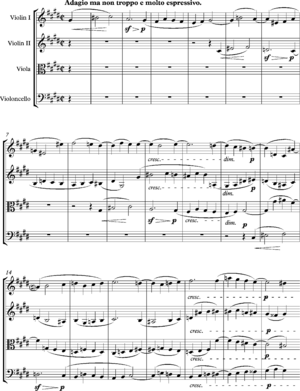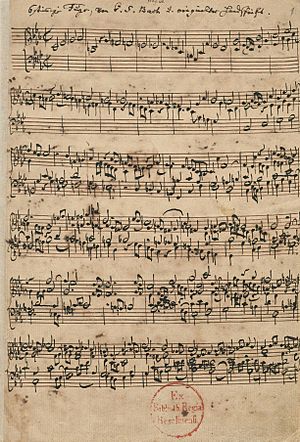Fugue facts for kids
A fugue is a special kind of music piece. It's written for a certain number of musical parts or "voices." The word "fugue" comes from the Italian word "fuga," which means "flight." Imagine the musical parts chasing each other!
Contents
How a Fugue Works
A fugue is built around one main tune, called the subject. Each musical part gets a turn playing this subject. When we talk about "parts" in a fugue, we mean the number of different voices or instruments playing. So, a "3-part fugue" means it's written for three voices or instruments.
Fugues can have 2, 3, 4, 5, or even 6 parts. The more parts there are, the harder it is to write. This is because each part needs to sound interesting on its own, but they all must fit together perfectly. Fugues with 3, 4, or 5 parts are the most common.
Starting a Fugue
A fugue always begins with just one part playing the subject. Then, the other parts join in, one by one, until they are all playing. When the second part comes in, it usually starts a bit higher or lower than the first. Musicians call this starting "on the dominant." This second entry is called the answer.
The third part to enter will play the original subject again. The fourth part will play another answer, and so on.
Types of Answers
If the answer is an exact copy of the subject, just starting on a different note, it's called a real answer. Sometimes, a note or two in the answer needs to be changed slightly so it sounds right. This is called a tonal answer. For example, if the subject starts with a "doh-soh" sound, the answer might start with a "soh-doh" sound.
Countersubjects and Free Parts
When the second part plays the answer, the first part doesn't stop. It plays something else, called a countersubject. If this "something else" is used every time to go along with the answer, it's a regular countersubject. A good countersubject sounds nice and works well whether it's played above or below the subject. This is called "invertible counterpoint".
If a part isn't playing the subject, answer, or a countersubject, it might just be playing a "free part."
Special Moments in a Fugue
Sometimes, a part might play the subject or answer again, even if it already had its turn. This is called a redundant entry.
When entries of the subject or answer overlap, it's called stretto. This can make the music feel more exciting and urgent. (Note: "stretto" can also mean "hurried" in music.)
If none of the parts are playing the subject or answer, and they are all playing free parts, this section is called an episode. If this happens during the very first part of the fugue (called the exposition), it's known as a codetta.
Because a fugue combines several melodic lines playing at the same time, it's a type of contrapuntal music.
Fugue Structure
A fugue usually has three main sections:
- The first section is the "exposition." This part lasts until all the parts have entered with the subject or answer.
- The middle section explores different musical keys (modulates).
- The final section returns to the main key. All the parts will likely play the subject or answer again, bringing the piece to a strong finish.
Famous Fugue Composers
Fugues became very popular during the Baroque period. They were often played after a "prelude," which was a shorter, introductory piece.
The most famous composer of fugues was Johann Sebastian Bach. He wrote two books, each with 24 Preludes and Fugues, called the "Das Wohltemperiertes Klavier" (The Well-Tempered Keyboard). He also wrote many Preludes and Fugues for the organ. Bach's fugues were so good that they became models for future composers. Musicians from later periods studied Bach's fugues to learn how to write their own.
Fugues can be very dramatic and exciting. As each part enters and the music builds, it creates a lot of tension. This is why many composers have ended long musical works with a fugue. It helps build excitement towards the end. Sometimes, a piece might not be a strict fugue but is "fugal." This means it starts like a fugue but then becomes freer.
For example, Ludwig van Beethoven used fugues a lot in the last movements of his later piano sonatas. Benjamin Britten wrote a fugue at the end of his famous piece, A Young Person’s Guide to the Orchestra. The composer William Walton started a fugue with a very long and fast subject in his choir song "The Twelve," but it quickly became a much freer piece of music.
Images for kids
-
Example of a false answer in J.S. Bach's Fugue No. 2 in C minor, BWV 847, from the Well-Tempered Clavier, Book 1. This passage is bars 6/7, at the end of the codetta before the first entry of the third voice, the bass, in the exposition. The false entry occurs in the alto, and consists of the head of the subject only, marked in red. It anticipates the true entry of the subject, marked in blue, by one quarter note.
See also
 In Spanish: Fuga para niños
In Spanish: Fuga para niños



